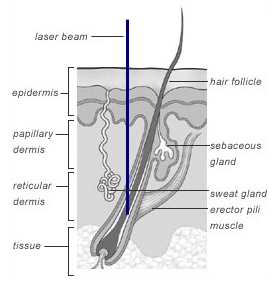Laser-Haarentfernung
Peer reviewed by The British Association of Plastic Surgeons (BAAPS)Authored by The British Association of Plastic Surgeons (BAAPS)Originally published 23 Mar 2016
Erfüllt die Anforderungen des Patienten redaktionelle Richtlinien
- HerunterladenHerunterladen
- Teilen Sie
- Sprache
- Diskussion
Diese Seite ist archiviert worden.
Sie wurde in letzter Zeit nicht überarbeitet und ist nicht auf dem neuesten Stand. Externe Links und Verweise funktionieren möglicherweise nicht mehr.
Dieses Merkblatt wird von der British Association of Aesthetic Plastic Surgeons (Britischer Verband der Ästhetisch-Plastischen Chirurgen) zur Verfügung gestellt, dem Berufsverband, der für die Förderung der Ausbildung und Sicherheit in der Ästhetisch-Plastischen Chirurgie zuständig ist.
In diesem Artikel:
Zu den traditionellen Methoden zur Entfernung unerwünschter Körperhaare gehören Rasieren, Wachsen, das Auftragen von Enthaarungscreme und Elektrolyse. Die Enthaarung mit dem Laser ist eine relativ neue Technik. Sie hilft nicht nur Menschen mit normalem Haarwuchs, sondern auch jenen, die unter übermäßiger Behaarung des Körpers oder des Gesichts leiden, einem Zustand, der Hirsutismus genannt wird und erhebliche psychische Probleme verursacht.
Hirsutismus betrifft etwa 10 % der Frauen im Alter zwischen 18 und 35 Jahren. In den meisten Fällen gibt es keine offensichtliche Ursache, aber bei einigen Patientinnen kann eine hormonelle Störung vorliegen. Hirsutismus kann auch ein Merkmal der Menopause sein. Unerwünschte Haare sind ein großes Problem für Transsexuelle und Transvestiten, und viele Männer mit Haaren auf dem Rücken stören sich sehr daran. Kinder mit behaarten Muttermalen im Gesicht oder im Bereich der Lendenwirbelsäule werden oft gehänselt.
Lesen Sie unten weiter
Haarbiologie
Haarbiologie

Das Haar wächst zyklisch und wechselt zwischen einer Wachstumsphase (Anagen) und einer Ruhephase (Telogen); Katagen ist die Übergangsphase zwischen den beiden Phasen.
Es wird angenommen, dass die Zellen auf halber Höhe des Haarfollikels für das Haarwachstum verantwortlich sind. Der Epilationslaser gibt eine bestimmte Wellenlänge des Laserlichts ab, die auf das Pigment im Haar abzielt. Dieses Licht dringt bis zu einem Millimeter unter die Haut, wo es vom Pigment in dem Teil der Haarwurzel absorbiert wird, der für das Wachstum wichtig ist.
Haare gibt es in verschiedenen Dicken und Farben, je nach dem Pigment, das sie enthalten. Schwarz- und Laserlicht dringt durch die Haut und wird bevorzugt von den Haaren absorbiert.
Man nimmt an, dass sich die für das Haarwachstum verantwortlichen Stammzellen am Ansatz des Musculus erector pili am Follikel befinden. Die braunen Haare enthalten die meisten Pigmente und sind am einfachsten zu behandeln. Graues oder blondes Haar hat wenig Pigment und spricht wahrscheinlich nicht auf die Behandlung an.
Behandlung
Die Behandlung kann etwas unangenehm sein - es fühlt sich ein wenig an, als ob ein Gummiband gegen die Haut schnappt -, aber manche Patienten ziehen es vor, zunächst eine Creme zur örtlichen Betäubung zu verwenden, um den Bereich zu betäuben. Auch Aloe-vera-Gel kann während oder nach der Behandlung verwendet werden, da es eine kühlende Wirkung hat. Einige Laser verfügen über ein Kühlsystem, das die Unannehmlichkeiten der Behandlung verringert.
Nach der Behandlung kann die behandelte Stelle rot aussehen und sich warm und empfindlich anfühlen. Dieses Gefühl verschwindet nach einigen Stunden, aber bei einigen wenigen Patienten, insbesondere bei denen mit dunkler Haut, kann es nach der Laserbehandlung zu Blasenbildung und Verkrustung der Haut kommen. Einige Haare verschwinden gleich nach der Behandlung, andere, die zunächst kraus oder "zerzaust" aussehen, können erst nach einigen Tagen ausfallen.
Lesen Sie unten weiter
Arten von Lasern
Inzwischen gibt es eine Vielzahl von Lasersystemen. Rubinlaser, Alexandritlaser, Nd-YAG-Laser und Weißlichtgeräte können alle mit unterschiedlichem Erfolg zur Haarentfernung eingesetzt werden. Die Größe der Fläche, die von jedem Laserimpuls erfasst wird, variiert je nach Gerät.
Ergebnisse
Die ersten Berichte über die Laserhaarentfernung waren äußerst vielversprechend, und einige Untersuchungen gingen sogar so weit zu behaupten, dass sie dauerhaft sein könnte, was jedoch im Allgemeinen nicht der Fall ist. Einige wenige Patienten sprechen überhaupt nicht auf die Laserbehandlung an, aber bei vielen werden gute Ergebnisse erzielt. Das nachwachsende Haar ist nicht nur weniger dicht, sondern auch weniger grob. Bei dem idealen Patienten mit dunklem Haar und heller Haut verschwindet das Haar in der Regel für zwei bis drei Monate und wächst dann langsam nach. Eine Wiederholung der Behandlung ist in der Regel mehrmals im Jahr erforderlich.
Lesen Sie unten weiter
Sicherheit
Bei einer Laserbehandlung ist es unerlässlich, dass alle Personen im Behandlungsraum, Sie und das Personal, eine Schutzbrille tragen. Der Zutritt zum Raum wird während der Behandlung streng kontrolliert.
Komplikationen und Probleme
Laserlicht kann die Pigmentierung der Haut schädigen, und manchmal kann die behandelte Stelle mehrere Monate nach der Behandlung ungewöhnlich blass oder dunkel werden. Aus diesem Grund ist es immer ratsam, eine kleine Probebehandlung an einer unauffälligen Stelle durchzuführen, bevor man zu einer umfassenden Behandlung übergeht. Das Testpflaster wird sechs bis acht Wochen später auf unerwünschte Nebenwirkungen untersucht, um den Erfolg sorgfältig zu beurteilen, bevor die Behandlung fortgesetzt wird. Besondere Vorsicht ist bei der Behandlung von Patienten mit schwarzer oder brauner Haut geboten. Der Nd-YAG-Laser ist für dunkle Haut am besten geeignet, da er weniger Hautschäden verursacht. Nach der Behandlung sollten Sie sich nicht in der Sonne aufhalten, denn wenn die frisch gelaserte Haut starker Sonneneinstrahlung ausgesetzt wird, kann sich das Risiko von Pigmentierungsproblemen erhöhen.
Die Zukunft
Gegenwärtig profitieren viele Patienten von der Laserhaarentfernung und erreichen haarfreie Intervalle von bis zu drei Monaten. Weitere Forschungsarbeiten werden die Ergebnisse in Zukunft wahrscheinlich noch verbessern. Dauerhaftigkeit, der Goldstandard der Haarentfernung, scheint jedoch noch in weiter Ferne zu sein.
Inhalt mit Genehmigung der Website der British Association of Aesthetic Plastic Surgeons verwendet: Laser-Haarentfernung. Das Urheberrecht für dieses Merkblatt liegt bei der BAAPS.
Haftungsausschluss
Dieses Merkblatt soll nützliche Informationen liefern, ist aber nicht als Ratschlag für einen bestimmten Fall zu verstehen. Sie ersetzt nicht die Notwendigkeit einer gründlichen Beratung, und alle potenziellen Patienten sollten den Rat eines entsprechend qualifizierten Arztes einholen. Die BAAPS übernimmt keine Haftung für Entscheidungen, die der Leser in Bezug auf die von ihm gewählte Behandlung trifft.
Patient picks for Cosmetic surgery

Chirurgie und Verfahren
Lippenvergrößerung
Dieses Merkblatt wird von der British Association of Aesthetic Plastic Surgeons (Britischer Verband der Ästhetisch-Plastischen Chirurgen) zur Verfügung gestellt, dem Berufsverband, der für die Förderung der Ausbildung und Sicherheit in der Ästhetisch-Plastischen Chirurgie zuständig ist.
von der britischen Vereinigung der plastischen Chirurgen (BAAPS)

Chirurgie und Verfahren
Brustvergrößerung
Dieses Merkblatt wird von der British Association of Aesthetic Plastic Surgeons (Britischer Verband der Ästhetisch-Plastischen Chirurgen) zur Verfügung gestellt, dem Berufsverband, der für die Förderung der Ausbildung und Sicherheit in der Ästhetisch-Plastischen Chirurgie zuständig ist.
von der britischen Vereinigung der plastischen Chirurgen (BAAPS)
Lesen Sie unten weiter
Artikel Geschichte
Die Informationen auf dieser Seite wurden von qualifizierten Klinikern verfasst und von Fachleuten geprüft.
23 Mar 2016 | Originally published
Verfasst von:
Der britische Verband der plastischen Chirurgen (BAAPS)Peer-Review durch
Der britische Verband der plastischen Chirurgen (BAAPS)

Fragen, teilen, verbinden.
Stöbern Sie in Diskussionen, stellen Sie Fragen, und tauschen Sie Erfahrungen zu Hunderten von Gesundheitsthemen aus.

Fühlen Sie sich unwohl?
Beurteilen Sie Ihre Symptome online und kostenlos
Sign up to the Patient newsletter
Your weekly dose of clear, trustworthy health advice - written to help you feel informed, confident and in control.
By subscribing you accept our Privacy Policy. You can unsubscribe at any time. We never sell your data.